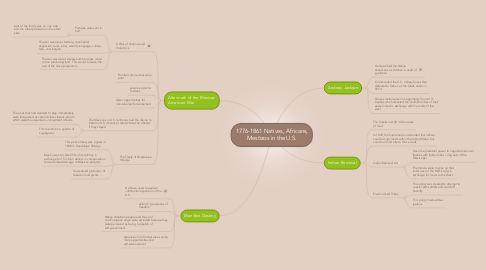
1. Aftermath of the Mexican American War
1.1. A War of Violence and Violations
1.1.1. Families were split in half
1.1.1.1. part of the family was on one side and the other part were on the other side
1.1.2. The war was about territory, continental expansion, land, labor, wealth, language, culture, race, and religion.
1.1.3. The war was about slavery and to access more cotton producing land. This would increase the size of the slave population
1.2. Frontier communities were poor
1.3. severe economic burdens
1.4. fewer opportunities for individual self advancement
1.5. The Mexicans in U.S. territories had the choice to become U.S. citizens or remain Mexican citizens if they stayed
1.5.1. The ones that had decided to stay, immediately were recognized as second class citizens, whom which were the unwanted, unimportant citizens.
1.5.2. This resutled in a system of segregation
1.6. The Treaty of Guadalupe Hidalgo
1.6.1. This peace treaty was signed in 1848 in Guadalupe Hidalgo
1.6.2. Mexico was to cede 55% of its territory in exchange for 15 million dollars in compensation for war-related damage to Mexican property
1.6.3. Guaranteed protection of Mexican land grants
2. Manifest Destiny
2.1. A phrase used to explain continental expansion of the U.S.
2.2. extend "boundaries of freedom"
2.3. Native American people and those of non-European origin were excluded because they were perceived as being incapable of self-government.
2.4. expansion into frontier areas came more opportunities and self-advancement
3. Andrew Jackson
3.1. He described the Native Americans as children in need of guidance
3.2. Commanded the U.S. military forces that defeated a faction of the Creek nation in 1814
3.3. He was instrumental in negotiating 9 out of 11 treaties which divested the southern tribes of their eastern land in exchange with the lands of the west
4. Indian Removal
4.1. The Creeks lost 22 million acres of land
4.2. In 1823, the Supreme Court decided that Indians could occupy lands within the United States but could not hold title to those lands
4.3. Indian Removal Act
4.3.1. Gave the president power to negotiate removal treaties with Indian tribes living east of the Mississippi
4.3.2. The Indians were to give up their lands east of the Mississippi in exchange for lands to the West
4.4. Five Civilized Tribes
4.4.1. This policy was created to attempt to coexist with settlers and ward off hostility
4.4.2. This policy made whites jealous

